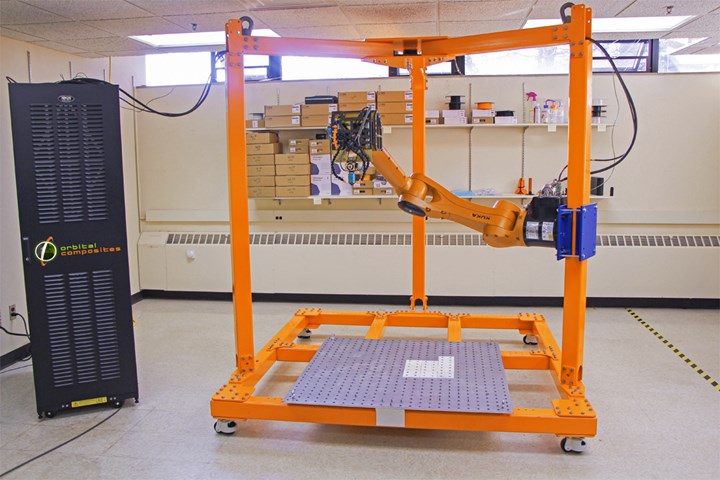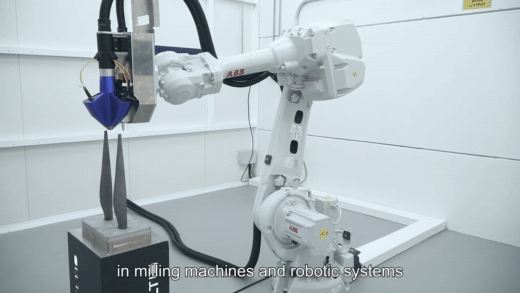Guide to Robotic Arm 3D Printing
What is robotic 3D printing?
Robotic 3D printing can mean different things in different contexts. In most cases, the term refers to robotic arm 3D printing– or robotic additive manufacturing (sometimes abbreviated “RAM”)–, a technology-agnostic form of 3D printing in which a printhead is mounted to a robotic arm, providing extra degrees of freedom.
But while this article will focus on robotic arm 3D printing, robotics are also used in other areas of 3D printing. With additive manufacturing now a common production process, industry 4.0 factories can use robots to automate industrial 3D printing, programming them to pick parts from a print bed and deliver them to a post-processing station.
Whether for multi-axis 3D printing or smart manufacturing, robotic 3D printing is on the rise and becoming an important part of additive manufacturing (AM).

How does robotic arm 3D printing work?
A typical Cartesian-style FDM 3D printer has a printhead that can move along the X, Y, and Z axes. Movement along the X and Y axes determines the shape of each horizontal layer, while movement along the Z-axis shifts the printhead upwards to the next layer.
Confusingly, a Cartesian-style 3D printer is in fact a perfect example of a cartesian coordinate robot (or linear robot), but we do not usually describe such 3D printers as robots.
A robotic 3D printer — that is, a 3D printer with a robotic arm — is different from an ordinary FDM printer. Robotic arms, which have articulated joints like a human arm, can move along and around multiple axes, so putting a printhead on the end of a robotic arm results in more degrees of freedom (often five or six; occasionally dozens). A robotic print bed that can rotate and/or tilt introduces further degrees of freedom.
But this range of movement can also make things complicated in a bad way. With so many moving parts, a robotic arm 3D printer requires more detailed and complex computer instructions in order to work. An FDM printer always has its printhead positioned above the printed part, while a robotic arm can reach around the part from many angles. Its multi-axis toolpaths must therefore account for different types of movement — often moving along or around multiple axes simultaneously — and must avoid collision with the part being built.
The actual printing technologies used on robotic 3D printers can vary. Extrusion technologies are common (polymers, concrete, continuous carbon fiber, etc.), as are directed energy deposition (DED) processes like wire arc additive manufacturing.

The robotic additive manufacturing market
Complete robotic 3D printers are limited in number, and those on the market typically use third-party robotic arms developed by industry specialists. Robotic 3D printers on the market include the CEAD AM Flexbot, which is fitted with a Comau robotic arm, and the MX3D M1, which has an ABB arm.
Many general-purpose robotic arms are suitable for robotic arm 3D printing (and some are explicitly designed for it). Leading industrial robotics companies like KUKA, ABB, and Stäubli build such systems.
And several AM companies develop end-of-arm printheads and extruders that can be mounted to these robotic arms to make a robotic-mounted 3D printer. The Weber Additive DXR direct extruder, for instance, is designed to work with a third-party 6-axis robotic arm. Spanish company Meltio offers a similar product, as does the aforementioned CEAD with its E25 and E50 printheads.
Some companies have also developed robotic 3D printing software. Ordinary slicing software cannot unlock the full potential of a robotic arm 3D printer, since it only accommodates layer-by-layer printing. The AdaOne cross-platform software service from ADAXIS calibrates, simulates, and executes robotic 3D printing operations, while ABB’s own RobotStudio offers powerful tools for AM users.

Some companies do not sell robotic 3D printers or software, but offer robotic 3D printing services using their own robotic 3D printing arm equipment. Robotics companies using 3D printing, such as Midwest Engineered Systems (which developed its ADDere robotic additive manufacturing systems using KUKA robots), offer part production services.
Advantages of robotic arms for 3D printing
Size
The majority of robotic 3D printers support large-scale robotic 3D printing. This is because the reach of most robotic arms far exceeds the build area of a typical 3D printer. KUKA says its robots can 3D print parts up to 30 meters in size.
Design freedom
Multi-axis 3D printing provides geometrical freedom. A 3D printing robot arm can, for example, print a curve (non-planar 3D printing), while an ordinary 3-axis FDM 3D printer can only approximate one: layers are often visible, producing a stepped effect.
Support-free
Robotic 3D printing can remove dependence on support structures in several ways. One way involves a moving print bed: tilting the print bed can turn a horizontal protrusion into a vertical one that doesn’t need supporting.
A more advanced solution is to use complex freeform 3D printing techniques. The Mediated Matter Group at MIT has used robotic arm 3D printing to print support-free structures in a way that mimics a silkworm spinning its cocoon.
Composite printing
Robotic additive manufacturing can improve composite printing. In 2016, Stratasys unveiled its prototype Robotic Composite 3D Demonstrator with KUKA robotic arm. Stratasys said the 8-axis system could enable “precise, directional material placement”, leading to stronger composite parts.
US-based company Continuous Composites has also explored continuous fiber reinforcement with their impressive CF3D technology.
More on continuous fiber reinforcement:
Carbon fiber 3D printers: 2024 guide to continuous fiber 3D printing
Limitations of robotic arm 3D printing
Cost
Robotic 3D printing is mostly used by industrial companies, because high-end robotic arms such as those from KUKA and ABB cost tens of thousands of dollars. Complete robotic arm 3D printers can cost upwards of $100,000.
Complexity
The complexity of robotic arm 3D printing can lead to complex, strong, and reinforced parts. But it can also result in lower accuracy than (high-end) gantry-style 3D printers, which have fewer moving parts. The likelihood of error and breakdown also increases with robotic printers.
Cross-platform issues
Robotic 3D printing systems often comprise arms and extruders made by different companies, which can lead to cross-platform issues. Users need reliable software to avoid these issues.
Robotic 3D printing applications
Robotic additive manufacturing has diverse applications. Large-scale robotic 3D printing is particularly suited to construction, infrastructure, shipbuilding, and industrial manufacturing, using materials as diverse as titanium and concrete.
With an ability to print on diverse substrates at virtually any angle, robotic arm 3D printing is also used for the repairs of large objects. And the rugged nature of industrial-grade robotic arms means these repairs can sometimes be carried out at remote locations like oil rigs. For the same reasons, robotic 3D printing lends itself well to hybrid manufacturing: printed sections can be added to cast, forged, or machined parts.
Other uses for robotic arm 3D printers include automotive manufacturing, aerospace manufacturing, and tooling: Viridis3D, a subsidiary of EnvisionTEC (itself part of Desktop Metal), built its RAM 123 printer specifically for foundry applications such as the fabrication of sand molds, cores, and patterns.
 English
English  Français
Français

